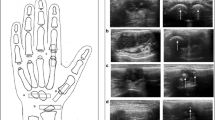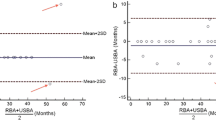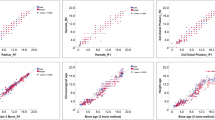Abstract
Background: Determination of skeletal development in children is important. The most common method of evaluation uses the standards of Greulich and Pyle (G&P) to assess the left hand radiograph. Numerous assessments may be made during follow-up. Objective: The aim of our study was to compare the accuracy of a new sonographic method with the standard radiographic method. Materials and methods: Seventy consecutive patients (age 6–17 years; 34 girls, 36 boys) underwent radiography of the left hand, followed by sonographic examination of the same hand using the BonAge system (Sunlight Medical Ltd., Israel). This system evaluates the relationship between the velocity of sound passing thorough the distal radial and ulna epiphysis and growth, using gender- and ethnicity-based algorithms. One experienced paediatric radiologist analysed the radiograph and assigned bone age scores based on the G&P atlas for the whole left hand and for the distal radius alone. The radiologist was blinded to the chronological age (CA), height of the patient and the BonAge result. Correlation between BonAge and G&P was undertaken. Results: In 65 patients, BonAge measurement could be performed successfully. In five patients, the scanning process was impossible using the ultrasound device. The r2 (r is the Pearson correlation coefficient) of the BonAge ultrasound measurement and the G&P method was 0.82. The averaged accuracy (i.e. absolute difference in years between G&P reading and BonAge ultrasonic results) was calculated. Results were similar for boys and girls: 1.0±0.8 years for the whole left hand and 0.8±0.7 year for the distal radius. On average, the difference between BonAge and CA is the same as the difference between G&P and CA, i.e. 1.4 years. Conclusions: The BonAge device demonstrates the ability of ultrasound to produce an accurate assessment of bone age. The results are highly correlated with skeletal age evaluated conventionally using the G&P method. Obvious advantages of the ultrasound device are objectivity, lack of ionizing radiation, and easy accessibility.

Similar content being viewed by others
References
Poland J (1898) Skiagrapic atlas showing the development of bone of the wrist and hand. Smith Elder, London
Greulich WW, Pyle SI (1959) Radiographic atlas of skeletal development of the hand and wrist. Stanford University Press, Stanford
Buckler JM (1983) How to make the most of bone ages. Arch Dis Child 58:761–763
Loder RT, Estle DT, Morrison K, et al (1993) Applicability of the Greulich and Pyle skeletal age standards to black and white children of today. Am J Dis Child 147:1329–1333
Ontell FK, Ivanovic M, Ablin DS, et al (1996) Bone age in children of diverse ethnicity. AJR 167:1395–1398
Jimenez-Castellanos J, Carmona A, Catalina-Herrera CJ, et al (1996) Skeletal maturation of wrist and hand ossification centers in normal Spanish boys and girls: a study using the Greulich and Pyle method. Acta Anat (Basel) 155:206–211
Groell R, Lindbichler F, Riepl T, et al (1999) The reliability of bone age determination in central European children using the Greulich and Pyle method. Br J Radiol 72:461–464
van Rijn RR, Lequin MH, Robben SG, et al (2001) Is the Greulich and Pyle atlas still valid for Dutch Caucasian children today? Pediatr Radiol 31:748–752
Tanner JM, Whitehouse RH, Marshall WA, et al (1975) Assessment of skeletal maturity and prediction of adult height (TW2 method). Academic, New York
Castriota-Scanderbeg A, De Micheli V (1995) Ultrasound of femoral head cartilage: a new method of assessing bone age. Skeletal Radiol 24:197–200
Wagner UA, Diedrich V, Schmitt O (1995) Determination of skeletal maturity by ultrasound: a preliminary report. Skeletal Radiol 24:417–420
Bilgili Y, Hizel S, Kara SA, et al (2003) Accuracy of skeletal age assessment in children from birth to 6 years of age with the ultrasonographic version of the Greulich-Pyle atlas. J Ultrasound Med 22:683–690
Megremis S, Cavallo G, Michalakou M, et al (2004) Assessment of skeletal age with hand and wrist sonography: could a standardised method replace radiography? Eur Radiol 14:S514
Castriota-Scanderbeg A, Sacco MC, Emberti-Gialloreti L, et al (1998) Skeletal age assessment in children and young adults: comparison between a newly developed sonographic method and conventional methods. Skeletal Radiol 27:271–277
Kreitner KF, Schweden FJ, Riepert T, et al (1998) Bone age determination based on the study of the medial extremity of the clavicle. Eur Radiol 8:1116–1122
Author information
Authors and Affiliations
Corresponding author
Rights and permissions
About this article
Cite this article
Mentzel, HJ., Vilser, C., Eulenstein, M. et al. Assessment of skeletal age at the wrist in children with a new ultrasound device. Pediatr Radiol 35, 429–433 (2005). https://doi.org/10.1007/s00247-004-1385-3
Received:
Revised:
Accepted:
Published:
Issue Date:
DOI: https://doi.org/10.1007/s00247-004-1385-3




